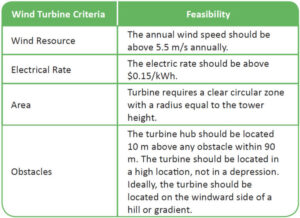Practical Application
Menu
Practical Application
- Review with local experts to determine whether wind is an appropriate energy source for the site (Table 5).
- Consult locally available wind data from airports, meteorological associations, or websites.
- Higher unobstructed elevations are better candidates for wind power.
- Contact local authorities to confirm whether wind turbines are allowed, and if so, identify the permitting process for erecting a turbine.
- Review at least one year of electricity bills to determine post’s typical consumption patterns to inform the wind system design.
- Work with local contractors to determine the best location, type, and size for the turbine, given specific site conditions, to estimate the investment cost for the proposed wind power system, and to determine requirements for its design, installation, and Cx.
- Develop a written system maintenance plan for facility operators to use. Identify cleaning and testing procedures and frequency, as well as resources for future repair and replacement.
Table 5: Wind turbine feasibility checklist


